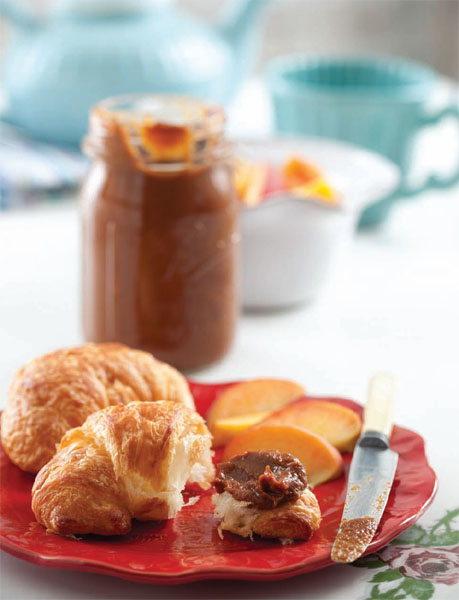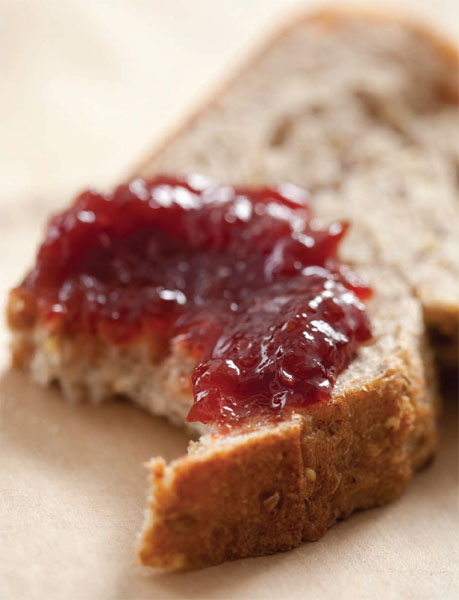Food in Jars (10 page)
Authors: Marisa McClellan

L
OTS OF PEOPLE HAVE FOND MEMORIES OF EATING
toast smeared with pumpkin butter. In recent days, food scientists have found that because of its density and low acidity, pumpkin butter isn't safe for home canning, even when using a pressure canner. That's why I recommend that you keep this butter in the freezer. Make sure not to skimp on the spices, as they help bring out the pumpkin flavor and create a truly autumnal butter.
5 cups/1.2l kg Spiced Applesauce (page 190)
3 cups/750 g plain pumpkin purée (canned is perfectly fine)
3 cups/600 g granulated sugar
Juice of 1 lemon
2 tablespoons ground cinnamon
1 teaspoon freshly grated nutmeg
1 teaspoon ground ginger
Combine the applesauce and pumpkin purée in a large pot. Bring to a gentle simmer and then reduce the heat to low. Cook over low heat for at least 1 hour, stirring every 10 minutes to prevent sticking. If the butter begins to spurt out of the pot, use a splatter shield to keep things neat.
After the first hour of cooking, stir the sugar, lemon juice, and spices into the butter. Stir and continue to cook over low heat, until the butter is thick and spreadable, about 30 to 45 minutes.
Remove the pot from the heat and ladle the butter into freezer-safe jars. The butter can be kept in the freezer for up to 1 year.


T
HERE ARE SOME WHO SAY THAT IT'S IMPOSSIBLE
to improve on a fresh summer peach. To them I say, try this peach butter. The oven roasting concentrates the flavor of the peaches and transforms them into a rich, spreadable condiment that is glorious on top of whole-wheat biscuits or just eaten straight with a spoon. This butter is easily made in larger batches with increased quantities.
3 pounds/1.4 kg yellow peaches
1 to 2 cups/200 to 400 g granulated sugar, or as needed
Zest and juice of 1 lemon
Preheat the oven to 350°F/180°C/gas 4. Prepare a boiling water bath and 3 regular-mouth half-pint/250 ml jars according to the process on page 10. Place the lids in a small saucepan, cover them with water, and simmer over very low heat.
Cut the peaches in half and remove the pits. Arrange them cut-side down in a single layer in a nonreactive baking dish (glass or ceramic is best). Roast for 30 minutes, or until the skins are loose.
Remove the baking dish from the oven and remove the skins from the peach halves and discard. Using a fork, mash the softened peaches in the baking dish. Reduce the oven temperature to 250°F/120°C/gas
½
. Return the mashed peaches to the oven and bake for an additional 2 to 3 hours, checking often to stir and prevent burning, until all the wateriness is gone and they are dark in color.
When the peaches have broken down sufficiently, taste the fruit and stir in 1 cup/200g sugar. Taste and add more sugar to taste. Stir in the lemon zest and juice.
Because this recipe makes such a small amount, I tend to skip the boiling water bath step and just keep it in the refrigerator. If you are short on fridge space, this butter can be processed for 15 minutes in a boiling water bath (see
page 11
).


W
HEN I FIRST STARTED CANNING, I DIDN'T
really get jelly. I didn't understand why anyone would mess around with something that was so seemingly fussy when there was a whole world of jams and fruit butters. But then someone presented me with a jar of homemade quince jelly and I got it. It wasn't fussy, it was refined. Making jelly is all about the extraction and concentration of flavors and it is worth the energy it takes to create a jar of wiggly, translucent fruit flavor.
That said, I'll be the first to tell you that I'm something of a cheater. Three of the jellies in this section start with pre-pressed or -squeezed juice. This is a choice that will make some purists grimace. I have found that as long as you start with high-quality juice, you can make a very good jelly and save yourself a whole lot of work.
As you head into jelly making, know that your first batch might not turn out perfectly. Jelly is a fickle preserve that can be affected by altitude, humidity, and the ratios of sugar to water in the juice you're working with. Keep trying and don't get discouraged.
To give your jelly the best chance for success, there are a few things you can do. Make sure to stash several small plates or saucers in the freezer at least an hour before you start cooking so that you can test your jelly as it cooks. Keep your thermometer close at hand. And make sure to keep a clear space next to the stove in case you need to move the pot off the burner quickly if it threatens to boil over.
You will note that there are a few recipes in this section that call for powdered pectin in place of liquid pectin. Powdered pectin sets up more firmly than liquid, which is a boon when you're trying to transform fruit juice into jelly. Make sure to whisk it fully into the sugar before beginning cooking, so that the pectin will be evenly distributed in the juice and won't clump up during cooking.

T
HIS JELLY STRIVES TO BE A SPREADABLE VERSION
of that beloved weekend brunch cocktail. It combines the tang of freshly squeezed orange juice with the pleasant buzz of sparkling wine. If you're looking for a good party favor for a bridal shower, put this jelly up in those adorable, 4-ounce/120 ml jelly jars and tie on a tag with a length of striped bakery twine. The cuteness of it all is certain to make your guests swoon.
4 cups/960 ml freshly squeezed orange juice
1 cup/240 ml sparkling wine
4 cups/800 g granulated sugar
2 (3-ounce/85 ml) packets liquid pectin
Prepare a boiling water bath and 3 regular-mouth 1-pint/500 ml jars according to the process on page 10. Place the lids in a small saucepan, cover them with water, and simmer over very low heat.
In a large, nonreactive pot, combine the orange juice, sparkling wine, and sugar and bring them to a boil over high heat heat. Cook, stirring frequently, for 15-25 minutes, until the volume in the pot is greatly reduced. While you continue to stir, clip a candy thermometer to the pot and watch until the jelly reaches 220°F/105°C. It should look thick and syrupy and the bubbles should look like bright orange molten lava.
Add the liquid pectin and boil for an additional 5 minutes. Test the set of the jelly using the saucer test described on page 77. If it doesn't pass, return the pot to the heat and cook for an additional 5 minutes before repeating the test.
When the jelly has reached the desired consistency, pour it into the prepared jars. Wipe the rims, apply the lids and rings, and process in a boiling water bath for 10 minutes (see
page 11
).

Q
UINCE IS SOMEWHAT OBSCURE BUT ABSOLUTELY
worth tracking down. It has fuzzy skin like a peach and smells intensely floral when fresh. It has incredibly dense flesh and is far too astringent to be eaten raw. When the flesh is chopped and simmered with water, it relaxes, turns vividly red and becomes wonderfully edible. It is the primary ingredient in membrillo, that rosy-hued fruit paste that is often served with Spanish cheese. Look for it in your local farmers' markets or ask an area orchard if they have some you can buy.
